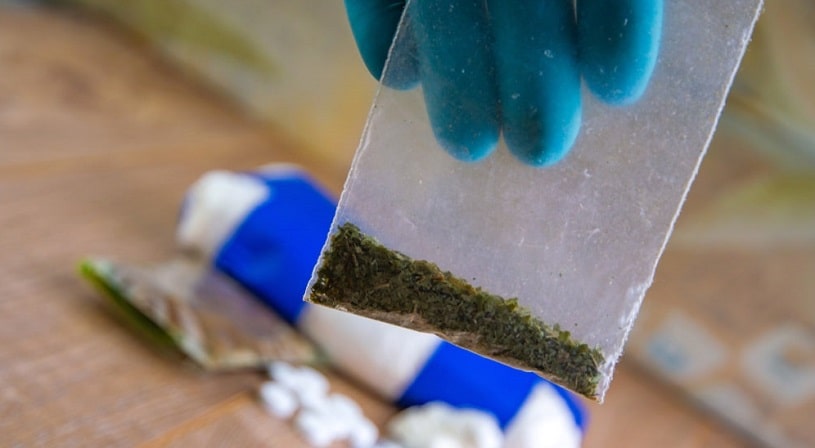While synthetic marijuana, also known as Spice or K2, was originally sold and touted as a safer, legal alternative to actual cannabis, health agencies now recognize it for the danger that it is. Spice drug has been shown to cause severe health problems, especially in habitual users. The use of fake cannabinoids is illegal in the United States and most of the world; however, most drug dealers label their product as “not for human consumption” for liability defense.
Table Of Contents:
What Is Spice?
Synthetic cannabis, also known as K2, synthetic marijuana, or “fake weed” is one of the designer drugs created to be a legal alternative to cannabis. Spice results from someone taking herbs or incense and spraying them with a chemical that mimics THC, the active chemical compound in cannabis.
Due to the illegal status of synthetic weed as a Schedule I classified substance, you can’t simply buy fake cannabis at your local pharmacy or a licensed marijuana dealership. Irrespective of this, the drug is usually sold by drug dealers, gas stations, vape shops, and online e-commerce sites disguised as incense, smoking blends, or herbal teas.
Spice drug creates a similar feeling to the one brought about by cannabis use. This is because it binds to the same receptors within the brain stimulated by THC, the active ingredient of cannabis. However, most fake cannabinoids bind more strongly to these receptors and are much more potent, leading to a more powerful and longer-lasting “high”.
Synthetic cannabis half-life hasn’t been studied properly by researchers as the drug is relatively new, but it’s believed that the drug’s effects last for more than a week.
Is Synthetic Marijuana Dangerous?
Synthetic cannabis is very dangerous. It was only thought to be safe when people did not know much about it. Using synthetic cannabis can have numerous negative effects on the body, including seizures, rapid heart rate, and even cardiac arrest in severe cases. In 2011, nearly 29,000 people had to visit the emergency room because of synthetic marijuana use.
Some Of the Possible Negative Side Effects Of Using Synthetic Cannabis Are:
- Confusion
- Seizures
- Rapid heart rate
- Paranoia
- Psychoses and hallucinations
- Cardiac arrest (in severe cases)
These are potentially dangerous and may lead to several life-threatening complications such as acute kidney toxicity, cardiac toxicity, and even synthetic cannabinoid poisoning.
Is K2 Legal In The United States: What Are the Implications?
Because of the ever-changing combination of chemicals, it is not clear if one can call synthetic cannabis a legal incense or an illegal drug. The legality often creates confusion even among the regulatory officials. They call it illegal today, and tomorrow a new product hits the market of which the ingredients change, lying beyond the reach of the existing laws.
As a matter of fact, national lawmakers can’t keep up. It takes far too long for them to pass a law, while the ingredients of Spice can change within a day. Manufacturers are taking advantage of this while exploiting yet another loophole in the law-making process. For example, the labels on synthetic cannabis read “not for human consumption” or “natural psychoactive material taken from various plants.” They sell under the pretense of incense, yet these false marketing claims may cause health problems for unknowing consumers.
Whether this substance is legal or not, it is hazardous and may cause severe health consequences.
If it were illegal, how would one be able to purchase it from a gas station? Conversely, if it were legal, why would the DEA ban so many chemicals in it? Unfortunately, not every official seems to be in a comfortable position to answer this.
DEA’s ban on many synthetic weed chemicals has not exactly been successful in curbing its production or sales for several reasons. As mentioned before, the manufacturers regularly change the chemicals in the products. Once the DEA bans certain chemicals, they take no time to replace them with equally or even more dangerous chemical products.
The label remains the same and has the same disclaimers though many products have now included new chemicals. Thus, it becomes almost impossible for researchers to find what they smoked or ingested. Technological advancements have made it possible to manufacture a new chemical in a very short duration.
Banned Chemicals In Spice
Spice Drug is known to contain numerous chemicals. Unfortunately, the ingredients keep changing. Some of them are new even to the investigating researchers. So, the question of their legality often vanishes without a proper answer. Nonetheless, the DEA has banned some chemicals in synthetic weed and categorized 15 synthetic cannabinoids (substances similar to THC) under Schedule I. For example, JWH-018, JWH-073, HU-210, and CP 47,497.
Remember the Schedule I substances have no known medical use, lack of safety data, and are very likely to cause an addiction.
Synthetic Marijuana Addiction
Synthetic marijuana or synthetic weed are chemicals that mimic the main psychoactive ingredient in cannabis. Due to the similarity synthetic cannabinoids share with marijuana, they also share many of its traits, including one of the worst aspects of the drug, its tendency to cause dependence. Even short-term spice drug users can suffer severe withdrawal if they attempt to quit. This can encourage extended and prolonged usage of the drug.
According to a 2014 report by the Substance Abuse and Mental Health Services Administration (SAMHSA), 12 thousand people had to visit the emergency room because of synthetic marijuana use in 2010. Of all the emergency room visits in 2010, almost 78% were males.
Physical Signs of Spice Addiction
Symptoms of Spice use are usually visible if a person knows what to look for. The signs of synthetic cannabis abuse can be both physical and behavioral.
Physical Symptoms May Include:
- Lowered inhibitions
- Slowed reaction times
- Sweating
- Bloodshot eyes
- Nausea
- Vomiting
- Slurred Speech
- Shaking
- Changes In Appetite
Behavioral Signs of Synthetic Cannabinoid Abuse
Spice addicts will show a range of different behavioral changes due to their dependence. These changes are a part of synthetic cannabis side effects and may go unnoticed if the users do not realize what to look for. It is important to recognize behavioral deviation in a spice drug user, as fake marijuana abuse symptoms can place the user and those around them in danger.
As aforementioned, synthetic weed can affect the brain as much as the rest of the body. There are many signs of spice drug abuse on the mind, with the most common symptoms not necessarily being the most severe.
The Most Common Psychological Symptoms Of Synthetic Weed Use Are:
- Unusual thought patterns
- Paranoia
- Anxiety
- Depression
- Delusions or hallucinations
- Mood swings or agitation
- Outbursts of rage
- Generally disordered thought processes
- Suicidal tendencies (in extreme cases)
- Lack of interest in hobbies
- Distancing from family and friends
Synthetic weed abuse can trigger a lack of self-respect and care. Interlinking with depression, this can be one of the most deadly behavioral and psychological effects of the drug.
Due to comedowns and the euphoria of the drug, there will be regular changes in the user’s mood. This can be one of the most evident signs that someone is smoking synthetic cannabinoids.
If one has a comedown, a user is more susceptible to their mood being out of character. Many users will be quickly enraged or angered for no reason. Moreover, the drug can trigger fatigue and dreariness in users, and lethargy is a common behavioral trait in those who use
When addicted to synthetic weed, an individual tends only to seek the drug. This then means their family and friends are pushed away by their mood swings and their only desire to take more synthetic marijuana.
Synthetic Marijuana Addiction Treatment
Spice addiction is at rapid growth, and as such, there are more K2 dependence rehabs to tackle the upsurge of this problem. More individuals seek fake marijuana help they need from standard rehab facilities all over the U.S and globally. Spice drug treatment was spawned from the increasing dependence on fake cannabinoids, sold as natural herbs. Rehab facilities are witnessing a breakout in the number of teens addicted to K2 due to its abuse as a supposed alternative to marijuana. Synthetic drug dependence treatment facilities cater to individuals dependent on K2 by providing tailored services to suit the needs of the individual. Inpatient and outpatient options are available and can stretch through an extensive period depending on the patient’s physical and mental condition.
There are many facilities today that provide K2 dependence support to addicts in three stages. These stages of treatment include the detox process, therapy, and aftercare programs. Each phase is essential for complete healing and requires complete dedication to the course.
Spice Detox Process
Spice’s dependence is unpredictable, and the substance contains many toxic ingredients that make fake marijuana even more harmful than marijuana. To effectively detoxify the body, it is imperative to note that the toxins build up in the body and strongly affect the CNS so that the abuser develops a level of dependency on the active ingredients. The mainline of K2 treatment is intense detoxification. To rid the body of the residues of fake marijuana.
The K2 detox process can last for several days. The patient may experience some unpleasant withdrawal symptoms during this period. The symptoms eventually fade after Spice will be removed from the system.
Spice detox period depends on levels of dependence and peculiarity of the case. It is not advisable to conduct self-detox as this could lead to complications and imminent relapse. The detoxification stage of K2 treatment should be done by trained medical specialists to ease the process, making it more bearable.
Therapies For Synthetic Marijuana Addiction
The next stage of K2 treatment is professional counseling. This process helps to build general health through educational and recreational activities. It also exposes possible mental issues and emotional inconsistencies that may be lingering.
This Stage Also May Involve:
- medication management,
- cognitive behavioral therapy,
- peer bonding.
These options are dedicated to further elimination of dependencies to fake marijuana.
Aftercare Program
The transitioning from addiction to a healthy life is best piloted through K2 addiction support programs. It comprises constant supervision, medication management, and personal counseling to eliminate vulnerabilities and prevent relapse, enabling the patient to maintain a sober lifestyle.
A Standard K2 Ccenter May Offer the Following Treatment Programs:
- 12-step treatment programs
- Non-12 step treatment program
- Faith-based programs
- Holistic programs
- Spiritual meetings
Spice Addiction Treatment For Teens
Teenagers are the most vulnerable to K2 addictions, and many rehabs are specifically open for teens. Some parents may not be so keen on opting for adult rehabs for their teens.
There are teen rehabs that treat young persons that are addicted to K2. Teen rehabs are most appropriate for young adults as they socialize with their peers and receive the right kind of emotional, physiological, and intellectual care they need. Since teens are usually less severely addicted than much older people, K2 treatment is often less strenuous.
Getting Help For Spice Addiction
Becoming dependent on a drug or alcohol is never easy to remedy. By the time someone realizes they have a problem, they have usually already suffered dire consequences from their drug use, such as loss of friends, jobs, or school or work performance has suffered. Some are arrested, or overdose before help is sought.
The first step to getting help is admitting that there is a problem and seeking help from friends and family members. Getting clean is far easier with the moral support of loved ones. Professional help is almost always preferable. Most people who attempt to get clean and sober on their own statistically carry a higher rate of relapse. There are various medical addiction treatment avenues for getting help available to those who have drug addictions:
- Support groups – Numerous support groups and group therapies are available for drug users. These offer accountability and peer to peer guidance. Group leaders or counselors are often also available for additional guidance.
- Outpatient therapy – Outpatient therapy means the person attends sessions at set intervals and then returns home. Their usual work and school routine would continue during this time, putting them at risk of encountering people or situations that might encourage a relapse.
- Inpatient therapy – Inpatient Spice rehabilitation centers are available to those who are serious about getting clean. These facilities involve some combined components of other therapy methods in a hospital environment where patients cannot access drugs. Those attending rehabilitation facilities have a much better chance of avoiding relapse than those who use one of the other methods alone. They usually continue treatment on an outpatient basis from home after their stay.
Page Sources
- National Institute on Drug Abuse. 2014. Synthetic Cannabinoids (K2/Spice). https://www.drugabuse.gov/drugs-abuse/synthetic-cannabinoids-k2spice NYC Health. 2015. K2 – Synthetic Cannabinoids. http://www1.nyc.gov/site/doh/health/health-topics/k2.page
- Office of National Drug Control Policy. 2015. Synthetic Drugs (a.k.a. K2, Spice, Bath Salts, etc.). https://www.whitehouse.gov/ondcp/ondcp-fact-sheets/synthetic-drugs-k2-spice-bath-salts
- Synthetic Cannabinoids: An Overview for Healthcare Providers. Centers for Disease Control and Prevention. https://www.cdc.gov/nceh/hsb/chemicals/sc/healthcare.html
- U.S. Drug Enforcement Administration, Diversion Control Division. (2016). Special Report: Synthetic Cannabinoids and Synthetic Cathinones Reported in NFLIS, 2013-2015. https://www.nflis.deadiversion.usdoj.gov/DesktopModules/ReportDownloads/Reports/NFLIS-SR-SynthCannabinoidCathinone.pdf
- U.S. National Library of Medicine, Synthetic Cannabinoids, https://www.ncbi.nlm.nih.gov/books/NBK424847/table/appd.t21/
- National Institute on Drug Abuse. Synthetic Cannabinoids (K2/Spice) DrugFacts. June 2020. https://www.drugabuse.gov/publications/drugfacts/synthetic-cannabinoids-k2spice
- Synthetic Cannabinoids: Epidemiology, Pharmacodynamics, and Clinical Implications. Marisol S. Castaneto, David A. Gorelick, [...], and Marilyn A. Huestis. August 2014. https://www.ncbi.nlm.nih.gov/pmc/articles/PMC4253059/
- Distinct pharmacology and metabolism of K2 synthetic cannabinoids compared to Δ9-THC: Mechanism underlying greater toxicity? William E. Fantegrossi, Jeffery H. Moran, [...], and Paul L. Prather. September 2013. https://www.ncbi.nlm.nih.gov/pmc/articles/PMC3945037/
- Drug-related Emergency Department Visits Involving Synthetic Cannabinoids. Donna M. Bush, Ph.D., F-ABFT and David A. Woodwell, M.P.H. October 2014. https://www.samhsa.gov/data/sites/default/files/SR-137/SR-1378.pdf
More About Illicit Drugs:









